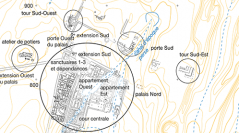

 Anthropozoologica
50 (1) - Pages 33-47
Anthropozoologica
50 (1) - Pages 33-47At the end of the Old Kingdom in Egypt, food production relies on a dense agriculture in the Delta and the Nile valley as well as on livestock herding and fishing. The situation is however different in the Western Desert which undergoes a strong aridification. Archaeozoological remains coming from the governorate palace of Ayn Asil in the Dakhla Oasis bring many evidence to understand animal’s exploitation and consumption practices in this arid and limited-resources environment. Analysis of bones fragments excavated in different sectors of the site show that livestock such as cattle, sheep and goats are highly dominant. Hunting practices supply also complementary food resources which are probably essential in this dry landscape. Wild species include mainly dorcas gazelle, oryx and barbary sheep. Herding is directed toward the production of meat with a secondary use of milk. Animal’s products such as bones and shells are also used for craft production. Associated with textual evidence, these results fit well with the general picture of food production during the Old Kingdom, with, however, characteristics peculiar to this oasis province.
Old Kingdom, herding, hunting, Balat/Ayn Asil, Egyptian Western Desert, archaeozoology